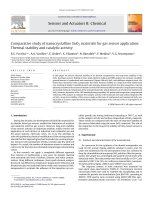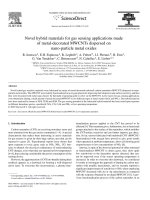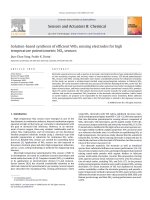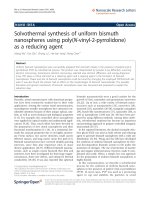Synthesis of work exchange networks for gas processing applications 2
Bạn đang xem bản rút gọn của tài liệu. Xem và tải ngay bản đầy đủ của tài liệu tại đây (55.6 KB, 7 trang )
Chapter 2 Literature Review
CHAPTER 2
LITERATURE REVIEW
Two types of systems approach considering LNG is available: Synthesis and Operation.
This work is related the later one and thus, the available literatures on LNG processes are
discussed in the following sections. Besides this, due to the unavailability of academic
research on work exchange networks, similar type of networks such as heat exchanger
networks is highlighted to understand the complexity and challenge of this novel
network.
2.1 LNG Refrigeration Processes
Due to the energy intensive nature of cryogenic refrigeration processes used in air
liquefaction plants and in the production of LNG, process optimization is extremely
advantageous as optimal process design and operation can result in substantial capital and
energy cost savings. An efficient facility is also a greener facility as it reduces carbon and
pollutant emissions into the environment. As a consequence, there had been numerous
publications by academic researchers on the optimization of cryogenic processes in the
open literature.
Majority of the publications centered on the optimal design of cryogenic
processes. There had been significant works on the synthesis of pure refrigerant cascade
systems. For instance, a work by Vaidyaraman et al.8, focused on the optimal synthesis of
refrigeration stages and their respective refrigerants to satisfy a given cooling load and
corresponding temperature and pressure while minimizing capital and operational costs.
The work was later extended to incorporate the use of mixed refrigerant where number of
10
Chapter 2 Literature Review
different types of mixed refrigerant cycles was calculated to minimize the total work
required by the system by determining temperature, pressure, and composition of each
stream9. Due to the complex and non-convex nature of this NLP model, they utilized an
iterative approach by incorporating FORTRAN90 and MINOS.
There had been also significant works in mixed refrigerant cryogenic processes.
Lee et al.10 proposed a combined thermodynamic and NLP approach to optimize the
selection of MR compositions in addition to the selection of key process variables such as
refrigerant flow and pressure levels. Recently11, Del Nogal et al. published a
mathematical optimization framework based on stochastic algorithms for the optimal
design of mixed refrigerant cycles.
Hasan et al.12 documented their works on the optimization of compressor
operations in an LNG plant to minimize power compressor power requirements via NLP
formulation. The work focused on the operational optimization of existing and well
known LNG refrigeration process namely Air-Products’ C3MR. Later13, they published
an MINLP formulation to optimize compressor load among any number of refrigeration
cycles. They demonstrated the benefit of their model by utilizing the latest AP-XTM
systems. As stated by Hasan et al., the aforementioned works serve as preliminary
investigations into the potential cost savings that could be derived from operational
optimization of existing facilities around the world. As such, operational factors such as
variations in NG feed composition, flow rate, and MR compositions were not taken into
consideration in their preliminary investigation and formulation. Hence, this work serves
as a more extensive study before developing the model as any number of cycles so that an
in-depth knowledge is gained on the behavior of the existing refrigeration system.
11
Chapter 2 Literature Review
This work focuses on the optimization of the AP-XTM system. There are two ways
in which an optimization could be carried out on the AP-XTM system, namely on the
design and the operation. Since the AP-XTM system is a relatively new patented
technology by Air-Products, the former aim is not feasible as the detailed technical
configurations and setups are proprietary and not available in the public domain. In
addition, design optimizations are also subjected to factors including client priorities,
costs, production levels and availability concerns. The alternate approach would be to
develop an operational optimization formulation based upon a simpler model built from
general arrangements and flow schematics of the AP-XTM system. This approach is more
feasible as basic schematics of the AP-XTM system are available from Air-Products
technical publication as well as from the AP-XTM patent6. Although detailed information
on the stream flows, temperatures, pressures, and equipment sizes are not documented,
the formulated model shall be generalized to accept the widest possible range of
specifications such that its applicability is not restricted to a single case or scenario. This
generality enables the optimization model to be applied over a range of operating
conditions including process fluctuations in the NG feed flow rate, compositions and
cooling water temperature.
2.2 Process Networks
The chemical industry accounts for about 20% of the total industrial energy consumption
in the USA14. Thus, conserving energy in chemical plants is crucial. The two common
forms of energy in chemical plants are heat and work. Even though work is more
expensive than heat, heat integration has been studied far more extensively than work
integration. This in spite the fact that many chemical plants such as gas processing and
12
Chapter 2 Literature Review
transportation, Liquefied Natural Gas (LNG), refineries, petrochemicals, air enrichment,
ammonia, fertilizer, etc. use air, gases, streams, and/or refrigerants at high pressures, and
compression work is a major need in these plants. In such plants, some streams need
work for compression, while others can produce work through expansion. For instance,
consider the LNG plant in Figure 2.1. Here, high-pressure natural gas (NG) is subcooled
by liquid CO2 in a multi-stream heat exchanger (MCHE) and then expanded to a lower
pressure to exchange heat with liquid N2. Then, it enters a turbine to further lower its
pressure to reach its storage pressure. The high-pressure liquid N2 passes through two
MCHEs to cool NG. It uses one compressor and two turbines to provide cooling as well
as produce work. Thus, while the MCHEs address heat integration, the plant has four
separate turbines and two compressors that are not systematically integrated to minimize
work requirements. If these turbines and compressors are integrated on one or more
SSTCs, then the losses arising in separate turbines/compressors from the supply and
delivery of work in disparate forms could be reduced or eliminated. Furthermore, it
would also be possible to integrate both heat and work simultaneously to conserve energy
further in the same network. In fact, the LNG industry in Qatar and other plants have
already begun exploring some simple options on an ad hoc basis to save energy by using
simple 2-stream SSTC units (one high-pressure and one low-pressure stream).
This idea of SSTC is a straightforward extension of a steam/gas turbine running a
compressor using a common shaft. The only difference is that a high-pressure stream
replaces steam/gas in the turbine driver. Of course, the idea can be generalized to include
multiple turbines with several high-pressure streams running multiple compressors with
several low-pressure streams using a single shaft. Configuring a network for exchanging
13
Chapter 2 Literature Review
work in this manner may be called “Work Exchange Network Synthesis” or WENS. It is
a useful and direct extension of the well known Heat Exchange Network Synthesis
(HENS)15,16. While the literature has studied networks for heat exchangers15,16, steam
turbines17,18, reactors19,20, separation21, mass exchange22,23, fuel gas24, and utility25,
surprisingly, no work has so far developed a systematic procedure for exchanging work
among multiple streams by matching high-pressure and low-pressure streams.
Figure 2.1 Process Flow Diagram (PFD) of an LNG process
Shin et al.26 proposed a Mixed Integer Linear Programming (MILP) formulation
for optimizing boil-off gas (BOG) compressor operations to minimize the total average
power consumption in an LNG receiving and re-gasification terminal. Hasan et al.27
optimized compressor operations for propane pre-cooled mixed refrigerant (C3MR)
cycles and minimized the total power cost for the refrigerant compressors. Del Nogal et
al.28,29 reported a model to obtain an optimal power system for utility networks. They
14
Chapter 2 Literature Review
considered gas turbine, steam turbine, helper motor/generator, and electric motor as
drivers to satisfy the given power demands of several compressor stages. They addressed
decisions to select appropriate gas/steam turbines as drivers for these stages.
Aspelund et al.30 proposed a graphical heuristic methodology based on Extended
Pinch Analysis and Design (ExPAnD) to utilize pressure-exergy for minimizing energy
requirements in sub-ambient processes such as LNG. They used compressors and
turbines separately to minimize the energy usage. However, they did not explicitly
mention the use of single-shaft turbine-compressor combinations to exchange energy.
Besides this, they only considered thermodynamic rather than cost aspects. Since
compressors and turbines are some of the most expensive equipment in a chemical plant,
a highly energy-effective process may be uneconomical. Besides, a heuristics-based
methodology may not offer the most economical network. Therefore, there is a need for a
cost-based structural optimization approach for work exchange network synthesis as
presented in this paper.
Razib et al.31 proposed a Mixed Integer Nonlinear Programming (MINLP)
formulation for integrating pressure energy among multiple streams using compressors
alone. For this, they used a staged superstructure for each stream. However, they did not
consider operational constraints such as surging and choking, and did not correlate speed
to work exchange. They also did not include both utility heaters and coolers in their
network.
15
Chapter 2 Literature Review
2.3 Research Focus
Based on the aforementioned discussions and challenges, this research project focuses on
the following aspects.
1. An NLP model is developed to minimize the compressor load among different
cycles in the latest AP-XTM refrigeration system. This optimization approach offers
optimal operational parameters for this process in different conditions such as
weather fluctuation, feed NG composition, MR composition, etc. It is worth to
mention that the model is able to optimally produce realistic operational parameters
that are very close to the real operations though the real design cannot be utilized
due to the proprietary restriction of this system.
2. As it is found that compressors are the preeminent energy consumers in the most
chemical and petrochemical industries, utilization of available energy can
economically save a lot of energy. Therefore, an MINLP formulation is utilized to
exchange both pressure and temperature energy among different streams to
minimize the total cost of the network. This study reveals that it is possible to save a
significant amount of energy while utilizing such a network.
16









